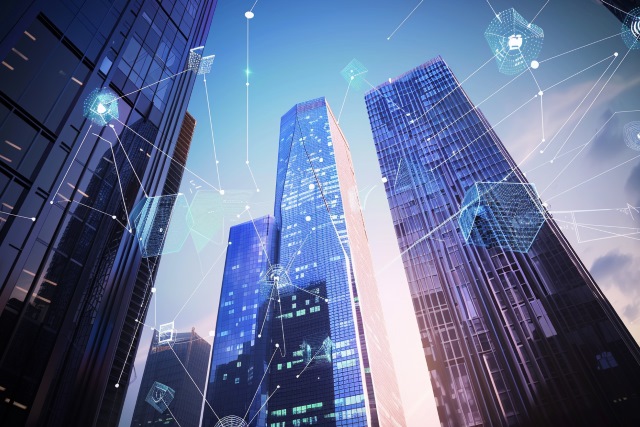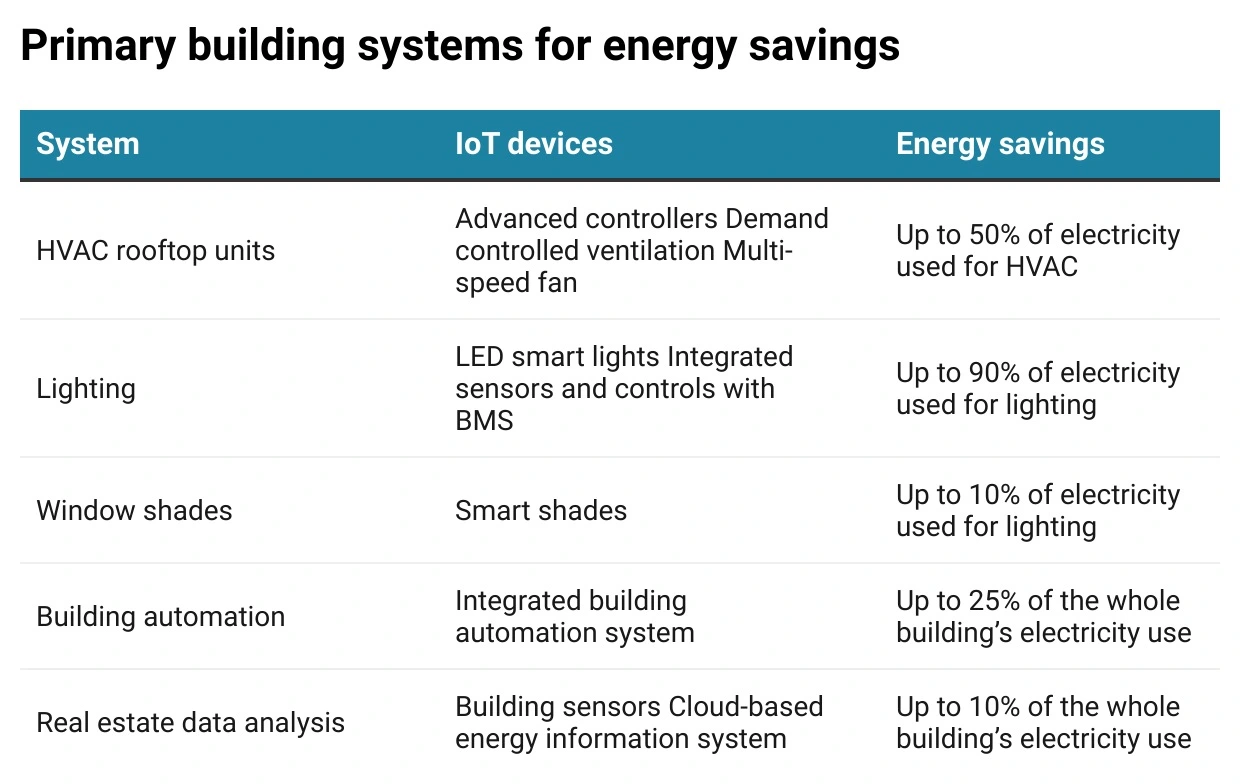The potential of IoT extends far beyond mere automation, propelling commercial real estate (CRE) buildings towards a future where every watt is accounted for, and every system is optimized for peak performance. This new era of smart energy management is not a distant vision. it’s a rapidly unfolding reality that promises to enhance operational efficiency, tenant comfort, and environmental stewardship.
Decoding IoT-based energy efficiency for CRE buildings
IoT-based energy efficiency is grounded in the ability to collect, analyze, and act on data in real-time. This is achieved by deploying networks of sensors and devices that monitor various facets of a building’s operation, creating an IoT monitoring system. When integrated with sophisticated analytics platforms, this data provides actionable insights to optimize energy usage and automate building systems for peak efficiency.
The potential savings are particularly impactful in CRE buildings, where energy consumption represents a significant portion of operating expenses. IoT enables a level of granularity in energy management that was previously unattainable. For example, by analyzing use patterns, IoT systems can adjust heating, ventilation, and air conditioning (HVAC) systems to align with occupancy levels, thereby avoiding unnecessary energy expenditure.
Key components of smart energy systems in commercial settings
At the core of IoT-based smart energy systems for CRE are several key components that work in concert to deliver energy efficiency and operational improvements:
- Sensors and actuators: These are the eyes and hands of the IoT ecosystem. Sensors collect data on everything from room temperature to occupancy levels, while actuators enable the physical control of systems based on sensor input.
- Connectivity: A robust and secure network is essential for IoT devices to communicate. This can range from wired connections to wireless protocols such as Wi-Fi, Zigbee, or cellular networks, depending on the scale and requirements of the system.
- Data processing and analytics: Raw sensor data is processed and analyzed, often using cloud-based platforms, to extract meaningful insights.
- User interface (UI): A user-friendly interface is crucial for building managers interacting with the IoT system. The UI typically comes in the form of dashboard displays, mobile apps, or web portals.
- Integration with building management systems: IoT energy solutions are often integrated with existing building management systems (BMS). Integrating these systems enables more coordinated control over building systems.
The benefits: What you gain from IoT in smart energy management
Implementing IoT energy management devices in commercial buildings can lead to significant energy savings. It can include everything from basic light sensors to automated HVAC systems. Here are the primary building systems you can save energy on by using IoT technology according to the American Council for an Energy-Efficient Economy:
Preparing for a smart building revolution in commercial real estate
To stay competitive and capitalize on the benefits of IoT, CRE stakeholders must embrace a proactive approach to technology integration. This involves installing IoT devices and cultivating a culture of innovation that allows for the seamless adoption of new technologies as they emerge. Staying informed about the latest developments ensures that CRE buildings are not left behind as tenant expectations evolve and sustainability becomes not just a buzzword but a business imperative.
Being proactive: What’s next for IoT in energy management?
As IoT technology advances, CRE professionals should look beyond current applications and anticipate future possibilities. The next wave of IoT in energy management is likely to involve:
- Machine learning energy optimization models: Advanced machine learning algorithms can analyze historical energy usage data alongside real-time inputs from IoT sensors to optimize building energy consumption.
- Demand response and load balancing: IoT can play a significant role in demand response programs where buildings reduce energy usage during peak demand times in exchange for reduced utility rates.
- Submetering: Implementing submeters enables more detailed energy usage data for individual tenants or systems, allowing for more accurate billing and incentivizing energy-efficient behaviors.
- Electrochromic glass: To reduce heat gain, electrochromic glass can adjust its tint based on the time of day and weather conditions. At the same time, IoT connectivity allows for remote control and data analysis to optimize their use.
The role of IoT in achieving sustainability goals
IoT technology is a critical enabler for the CRE industry to attain its sustainability objectives. Below are specific ways in which IoT contributes to these goals:
- Building automation systems: Using IoT devices for real-time information, building automation systems can automatically react to environmental conditions.
- Asset management: With current and historical data, IoT monitoring devices can help CRE managers better predict equipment failures before they occur through predictive management systems.
- Smart grid integration: Buildings can become energy producers and consumers with IoT-managed solar panels or wind turbines, contributing to a more sustainable energy ecosystem.
- Green certifications: IoT-driven data collection can support CRE buildings in achieving and maintaining ESG Green Buildings certification by accurately tracking and reporting energy and water usage, indoor air quality, and other environmental factors.
Implementing IoT-driven energy management in your facilities
By leveraging IoT technology, CRE professionals can gain unparalleled insights into their energy consumption, optimize building operations, and enhance the overall tenant experience. However, the path to integration can be complex and requires careful planning and execution.
Steps to integrate smart energy solutions in CRE
Here are the fundamental steps property managers can take to integrate smart energy solutions into their facilities:
- Assessment: Begin with a comprehensive assessment of your current energy systems to identify inefficiencies and areas for improvement.
- Technology selection: Choose the proper IoT devices and sensors that align with your goals. Consider factors such as compatibility with existing systems, ease of installation, scalability, and data security.
- Infrastructure review: Ensure that the building’s infrastructure can support the chosen IoT solutions. This may involve upgrading network capabilities, ensuring robust Wi-Fi coverage, or installing additional wiring.
- Pilot program: Before a full-scale rollout, execute a pilot program in a selected area of your facility to work out any early issues.
- Data management: Develop a strategy for handling the vast amounts of data IoT devices generate.
- System integration: Integrate IoT devices with your existing building management systems. Seamless integration is crucial for centralized control and unified data analysis.
- Change management: Train your staff to use the new systems and manage the change effectively within your organization. Ensure that everyone understands the benefits and knows how to leverage the new technology.
- Monitor and optimize: Once the systems are in place, continuously monitor performance and make adjustments as needed.
Common challenges in IoT energy management and how to overcome them
Challenges:
- High initial investment – Many businesses worry about the cost of implementation.
- Complex integration with legacy systems – Not all buildings are designed for IoT.
- Data security concerns – More connected devices mean more potential vulnerabilities.
- Lack of expertise – CRE managers may lack technical knowledge on IoT deployment.
Solutions:
- Leverage scalable IoT solutions that allow gradual investment.
- Use open standards like ProptechOS for seamless integration.
- Adopt secure, encrypted communication protocols to prevent cyber risks.
- Partner with IoT specialists to manage deployment and training.
How IoT energy management impacts net zero goals
Key contributions of IoT to net zero buildings:
- Real-time monitoring reduces energy waste – Track and adjust consumption patterns dynamically.
- Automated demand response – Shift energy loads during peak times to optimize grid efficiency.
- Integration with renewable energy sources – IoT enables smart grid interaction for solar and wind energy.
- ESG compliance tracking – Automated data collection supports sustainability certifications (e.g., LEED, BREEAM).
Example: A commercial office in Stockholm reduced its carbon footprint by 25% using an IoT-driven HVAC optimization system.
The Future of IoT energy management: What’s next?
Emerging Innovations:
- AI-powered predictive analytics – Systems will autonomously optimize energy use based on historical patterns.
- Digital twins for real-time simulations – Create virtual building models to test energy efficiency improvements.
- Blockchain for energy transactions – Decentralized energy management could enable peer-to-peer energy sharing.
- Edge computing for faster processing – IoT devices will analyze data locally rather than relying solely on the cloud.
Future Outlook: Experts predict that by 2030, over 75% of commercial buildings will adopt some form of IoT-driven energy optimization.
Case study: Transforming a CRE portfolio
Scenario:
A large CRE firm with multiple office buildings struggled with high energy costs and inconsistent tenant comfort.
IoT solution implemented:
- Installed smart HVAC controls to adjust the temperature based on occupancy.
- Deployed submeters for granular tenant billing, encouraging energy-efficient behavior.
- Integrated AI-powered analytics for predictive maintenance, reducing equipment downtime.
Results:
✅ 20% reduction in annual energy costs
✅ Improved tenant satisfaction due to better climate control
✅ Achieved Green Building Certification within 12 months
Takeaway: Implementing IoT energy management doesn’t just cut costs—it enhances sustainability and tenant experience.
Connectivity solutions: Ensuring seamless communication through ProptechOS
By using open standards, ProptechOS brings connectivity to disparate CRE technology. From your IoT sensors to your data analytics and building management tools, with ProptechOS, all of your solutions can work together to make your portfolio more efficient. This also ensures that any future upgrades to your hardware or software side remain connected. Unlock the power of communication between your real estate data and Proptech solutions with a free trial of ProptechOS.
Q: What is IoT energy management? A: IoT energy management refers to the use of smart devices and sensors to monitor, analyze, and optimize energy usage in buildings, reducing waste and improving efficiency.
Q: How does IoT contribute to sustainability in CRE? A: IoT helps CRE buildings achieve sustainability goals through real-time monitoring, automated demand response, smart grid integration, and energy-efficient automation.
Q: What are the key challenges of implementing IoT in energy management? A: Challenges include high initial investment, integration complexities, data security concerns, and the need for specialized expertise.
Q: What are the future trends in IoT energy management? A: Emerging trends include AI-driven energy optimization, digital twins, blockchain-based energy transactions, and edge computing for real-time data processing.

Dr. Erik Wallin
Chief Ecosystem Officer, and founder of ProptechOS and RealEstateCore is recognized as a leader in Building Operating Systems (BOS) and making the buildings of the world smarter. He holds an MSc and a Ph.D. in Media and Computer Science from KTH Royal Institute of Technology.
Read his full bio and information here.


